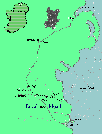
|
|
|
|
|
|
|
|
|
|
|
|
|
|
|
|
|
|
|
|
HOWTH: Teia Tephi landed at Howth on the 18th. of June 583 B.C., and was greeted there and carried ashore by Eochaidh Mac Duach, the Ard ri (high king) of Ireland. She spent that night at Howth staying at the palace of Crimthann which was built on the Hill of Howth.
THE HILL OF TARA: The next day Teia Tephi was taken to Cathair Crofinn (now known as The Hill of Tara), where she married Eochaidh, the high king of Ireland, and they gave their pledges of marriage over the Lia Fail Stone (Jacob's Pillar - The Stone of Destiny) that Teia Tephi had brought with her from Jerusalem. She then stood upon the Lia Fail Stone and was acknowledged queen of all Ireland and Eochaidh as Ard ri. Tephi and Eochaidh had four children, her firstborn son, Aedh, died as a teen-ager and was buried in the Mound of The Hostages at Tara. A special subterranean tomb was constructed beneath the Mound of The Hostages and Teia Tephi was buried in it, when she died, along with a number of extremely significant artifacts including David's Harp, which features as the Irish people's national emblem, and The Ark of The Covenant.
SLANE: The Battle of Unna; also known as the battle of the second Moytura (meaning "plain of towers" - the Boyne Valley); was held at Slane. In Irish mythology, Tephi's warriors who were slain in the battle were placed in the Well of Slane and were brought back to life to terrify their enemies on the battle-field the next day.
KNOWTH: There was a total of 6668 people killed in the Battle of Unna, most of whom were buried in the Boyne Valley. The warriors of high rank who fell at the Battle of Unna were buried in the Knowth burial-mound and those of lower rank were buried in the many satellite graves around Knowth and throughout the Boyne Valley.
DOWTH: Bressail, the leader of those who rebelled against Teia Tephi in the battle of Unna, survived the battle. The people never forgot his arrogance, greed and meanness and when he died he was buried in a grave that was made to face the setting sun rather than the sun-rise and his grave was named Dowth which is derived from the ancient Gaelic word "Dubad" meaning darkness.
NEWGRANGE: Teia Tephi's third child and second son, Aengus succeeded his older brother Aedh to the Throne and became high king of Ireland after his parents' death. He grew up to be very arrogant and had the grandest tomb in Ireland built for himself to be, in his belief, immortalized in, and was buried there at Bru na Boann (Boyne) which means "The dwelling of Aengus, son of Bo." (Bo or Bovinda meaning "the heifer" - the source of the milk of human kindness - Teia Tephi).
TELTOWN: Teia Tephi and Eochaidh had a palace built at Teltown, near Kells, where they lived and where Teia Tephi wrote her amazing autobiography, "The Book of Tephi, Queen of Tara and Gibraltar." Before she died on the 1st of August 534 B.C., she asked the people to remember her by holding games at Teltown in her honour. The Teltown Games were held to remind people of her and The Torah which is the name given to God's Laws; Statutes and Judgments contained in The First Five Books of The Bible and in The Ark of The Covenant, which she had brought with her from Jerusalem. The games were to help teach the children to behave themselves and rewards were given to those who upheld The Laws of The Torah and were the most humble.
CAIRN T, LOUGHCREW: Jeremiah the Bible Prophet, also known in Irish history as the Ollamh Fodhla (wise teacher), who brought Teia Tephi to Ireland from Jerusalem was buried in Cairn T. The second stone on the left as you enter the tomb depicts the boat journey they made from Taphanes (Tanis) in Egypt to Ireland, changing boats at Gibraltar and stopping at Breogan in Spain and Marazion in Cornwall on the way. The stone also gives astronomical calculations, done in great detail, which give the date when Jeremiah died and also when the Battle of Unna was fought. Jeremiah's Judicial (Judgment) Seat, which he sat upon when he taught the people God's Laws contained in The Torah, is situated on the Northern side of the tomb , just to the right of the entrance, but has in recent times become known as the Hag's Chair.
CIAN ANNUS MOR (KELLS): Ith Cian, the Israelite ruler whom Teia Tephi visited at Breogan in Spain on her way from Jerusalem to Ireland, later came to Ireland to visit his son Lughaidh, but was killed near Kells by three Tyrian men whom he had previously driven from Spain. Ith Cian was buried on the highest point in Kells, which was the mound that Columba's (Columcille's) house is built into the side of, until recently when the Kells Garda Station was built on mechanically raised ground next to it. Kells' original name is Cian Aneas Mor which means Great Cian from the South, referring to Ith Cian, ruler of Spain (Spain is referred to in "The Book of Tephi" as the Sun-lands of the South).
There are many other sites in Royal Meath and surrounding areas in Ireland that are associated with Teia Tephi, but the above are the most relevant ones. Other sites include Tlachtga, Rath Lugh, Navan, Mullagh Hill in Co. Cavan and Navan Fort and Carrickfergus in Northern Ireland. The people at Navan Fort are keen to co-operate with us in linking all of the associated sites to promote tourism in a joint North - South venture to help the peace process.

|
|
|
|
|
|
|
|
|
|
|
|
|
|
|
|
|
|